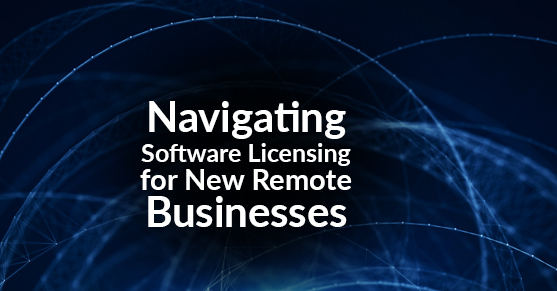The repercussions of the COVID-19 pandemic have carved their way into every nook and cranny of business, and software licensing has not been immune to the rapid changes in business operations. As many companies began transferring their employees to remote work, they also began juggling a variety of licensing options for their new business locations — i.e., employee homes. This opened a floodgate of software licensing needs — from acquiring new communication software and remote ticketing resources to extending user permissions in existing software and applications.
The necessity of the swift transition highlighted the need for a previously unforeseen strategy: how does a company transition its software licensing for remote work? Over the past few weeks, we’ve been helping our clients solve that riddle, and we wanted to offer a few best practices we’ve learned to help your business navigate the pressing licensing questions.
Know the Devices and Software Employees Are Using
This is a given for any company, remote or not. However, the current circumstances have made it a little more complicated, and some companies are losing track of licensing metrics, the number of users, new devices, etc. Six months ago, an entire company may have been working in a single office, utilizing company desktop PCs with access to on-premise servers and applications. Now, they’re having to transition to cloud/hybrid environments, accessing utilities via personal computers and other devices. The playing field is changing, and with it are licensing needs, metrics, and contracts.
When your company moves to home offices, you’re putting your company in a position to have a software shortage. Did you know some vendors count device connectivity as a user in certain situations? In that scenario, working at home while using your smartphone, your laptop, your workstation, and your tablet could count as four users. Multiply that with the number of employees and you could be in for a surprisingly high audit bill. The best course of action is to familiarize yourself with software metrics; if you can’t, find a professional to help you.
So, before the number of remote workers grows or you decide to maintain remote employment with your staff, conduct a thorough internal audit of all software, devices, and user access. It might take some time, and you may want to invest in a Software Asset Management (SAM) tool, but the payout will be worth your efforts.
Get the Right Licenses
Again, this is a given, but the necessity of proper licensing has never been so crucial. After conducting the internal audit, review the licenses you have and confirm that they match up with your current environment. If they don’t, contact your vendor and figure out the best course of action to put your company in a better position for compliance in case of an audit.
Also, we’d like to note that getting the right license isn’t just about the audit. Having the correct licenses is about making sure your employees have everything they need to do their job and serve your customers. So, while keeping potential audits in mind is a good practice, keeping employee satisfaction (and, thus, your customers) at the forefront of your efforts is an even better one.
Assess Your Company’s Preparedness
Having an idea of all potential opportunities for your licenses and the risks involved will provide your business with a higher level of preparedness. You can respond to the rapid changes the pandemic has and continue to present when you know where the risks are and where you could innovate. Some questions to ask are: Do current licenses provide value to your business with consideration of your economic position? Are you in a position to renegotiate current licenses? Is your business capable of addressing its licensing needs and optimization as the company transitions? Are you prepared for an audit? These are critical questions that will provide endless value during an unprecedented business climate.
Enforce Data Security Protocols
As businesses move from office to remote work, security risks grow exponentially — personal devices may not have the necessary encryptions, network connections may not be secure, there may be access control issues, etc. All businesses should be implementing robust security features, and companies with sensitive data — healthcare, government, finance, etc. — require expansive security software and strategies for remote workers. We tell all of our clients making the transition to ensure their employees have the same encryption and security across all devices.
Plan for the Future of Remote Work
Not many things are guaranteed right now, but the repercussions of the COVID-19 pandemic have shown that remote work is a viable and effective way to operate your business. It doesn’t work for every company, but for those finding success, now is the time to plan for a remote future. Evaluate your licensing contracts and metrics, review usage and user access, check on new pricing models, pinpoint optimization areas, and create a software landscape to match your new business model.
Although software audits have been a big part of confirming proper software licensing, the pandemic is revitalizing the focus for many vendors. They’re not trying to “getcha,” instead they’re trying to cover their bases, as the transition between licenses can create a landfill of misuse. By following these best practices as your business transitions to remote work, you’ll be prepared for an audit.
The ultimate goal is to make sure your technical environment aligns with the contracts you have with software providers, and if you need help, we’re here to support you. Reach out to us with any questions or concerns you have in the comments below, or contact us here.
This post was originally published here.

